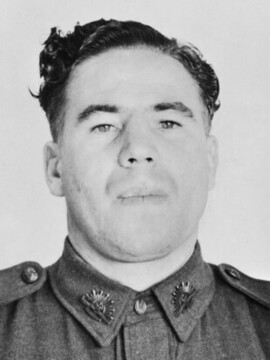
MURRAY, Richard
| Service Number: | NX33361 |
|---|---|
| Enlisted: | 12 August 1940 |
| Last Rank: | Private |
| Last Unit: | 2nd/19th Infantry Battalion |
| Born: | Hamilton, Scotland, 28 November 1914 |
| Home Town: | Botany, New South Wales |
| Schooling: | Not yet discovered |
| Occupation: | Boxer / Labourer |
| Died: | Murdered by his Japanese captors (Prisoner of War), Ranua, Borneo - 2nd Sandakan Death March, 20 May 1945, aged 30 years |
| Cemetery: |
Labuan War Cemetery Grave 7 Row E Plot 21 - formerly "unkown soldier" . Richie Murray's grave was identified by author Lynette Silver during the course of research for her book "Sandakan Conspiracy of Silence". , Labuan War Cemetery, Labuan, Malaysia |
| Memorials: | Australian War Memorial Roll of Honour, Ballarat Australian Ex-Prisoners of War Memorial |
World War 2 Service
| 12 Aug 1940: | Enlisted Private, NX33361, 2nd/19th Infantry Battalion | |
|---|---|---|
| 12 Aug 1940: | Enlisted Australian Military Forces (WW2) , Private, NX33361, 2nd/19th Infantry Battalion | |
| 7 Dec 1941: | Involvement Private, NX33361, 2nd/19th Infantry Battalion, Malaya/Singapore | |
| 28 Mar 1943: | Involvement Private, NX33361, 2nd/19th Infantry Battalion, Prisoners of War, Assigned to 'E Force' Borneo - Sandakan | |
| 20 May 1945: | Involvement NX33361, E Force Sandakan - Executed by his Japanese captors - see 'Personal Stories' |
"Greater love hath no man................"
Private Richard Murray sacrificed himself to protect his mates after the theft of rice from a Japanese cache was discovered by Camp guards at Ranau in May 1945.
"Then, to Botterill's horror, Richie Murray stepped forward. In a clear firm voice, he told Suzuki that he had stolen the food and that he, and he alone, was responsible.
He was taken at bayonet point to a tree outside the Japanese hut and tied up while the rest of the prisoners were told to get on with their work, which for Botterill, was cutting wood down at the Formosan quarters. He couldn't see what was going on but he figured that Suzuki would keep Murray tied to the tree overnight. After dark he would cut Murray loose and escape, possibly with Allie and Grist as previously planned. They would have to flee immediately of course, but with the rest of the stolen food still safely hidden in the jungle, at least they would have a fair chance of making a good break before the alarm was raised.
About an hour later, Botterill looked up to see Murray disappearing down the track under escort. He couldn't identify the guards, but some English prisoners, working in the main kitchen on the other side of the Formosan hut, had a clear view. They watched, horrified, as Suzuki, accompanied by a guard escort which included Kawakami (The Gold Tootheed Shin Kicking bastard), Mori Shoichi and Yoshiya Kinjo, took Murray, who had been savagely beaten, down the track at bayonet point. Twenty minutes later the guards returned without him. Botterill's worst fears became a hideous reality when Kawakami swaggered down to the Formosan hut and made a great show of wiping his bayonet on the grass, boasting to his fellow guards that he had 'blooded his blade' on the prisoner."
Keith Botterill was one of only six Australian survivors of the two Sandakan Death Marches.
Suzuki and Kawakami were hanged at Rabaul on 18 Oct 1946 for another similar atrocity. They were never tried for Murray's death but were convicted largely on the testimony of Keith Botterill and Bill Moxham, another of the six survivors.
Sandakan - Conspiracy of Silence 1998 Lynette Ramsay Silver Sally Milner Publishing ISBN I 86351 223 3 . pp 210-211
Submitted 27 May 2017 by Steve Larkins
Biography contributed by Steve Larkins
See related 'Personal Story'
Biography contributed by Gary Hockley
Son of Frank and Catherine Murray; husband of Margaret Murray, of Hurstville, New South Wales.











